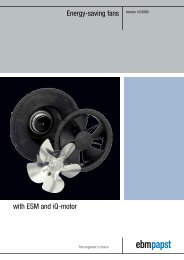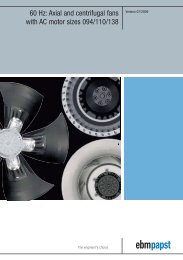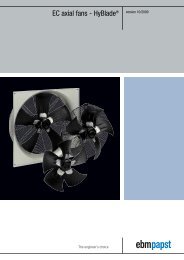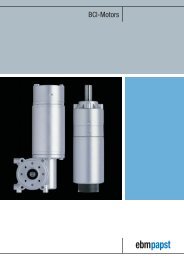Download [PDF] 2.1 MB - ebm-papst UK
Download [PDF] 2.1 MB - ebm-papst UK
Download [PDF] 2.1 MB - ebm-papst UK
Create successful ePaper yourself
Turn your PDF publications into a flip-book with our unique Google optimized e-Paper software.
GREEN IT<br />
Figure 2: The RadiPac series is available with a drive output<br />
from 500 watts to 12 kilowatts in outer diameter sizes from<br />
250 mm to 1,250 mm.<br />
fan. Whether operating under full load or especially<br />
under partial load, both fan series operate<br />
with high efficiency and are exceptionally quiet.<br />
Controllability, bus networking, redundancy<br />
and long service life Another advantage is the<br />
compact dimensions of the fans. The electronically<br />
commutated external rotor motor is directly<br />
integrated into the impeller, which dramatically<br />
reduces the installation dimensions. The electronics<br />
integrated in the drives are not only ideally<br />
matched to the EC motors used, they can also<br />
be controlled with either a 0-10 V analogue signal<br />
or digitally with a MODBUS interface. For the<br />
fan arrays in which many fans are used in parallel,<br />
the bus networking offers advantages: From<br />
making configurations during commissioning to<br />
performing service, alarm diagnosis and maintenance,<br />
dealing with the technology becomes<br />
substantially easier if the technician can use a<br />
central computer to access the fans. Moreover,<br />
by means of the MODBUS interface the fans from<br />
<strong>ebm</strong>-<strong>papst</strong> can be integrated into a BMS (Building<br />
Management System) or DCIM (Data Center<br />
Infrastructure Management). This interface<br />
makes the motor speeds continuously variable.<br />
which provides a very convenient option for demand-oriented<br />
performance adaptation. Thus the<br />
air performance of the fan arrays can be perfectly<br />
matched to the specific ambient and operating<br />
conditions of the data centre. At the same time,<br />
it is easy to incorporate the necessary redundancy<br />
in the event of a fan failure. The speed of<br />
the “neighbouring fans” is increased so that the<br />
same air flow is maintained.<br />
Figure 3: The “RadiCal” centrifugal fan for<br />
applications in ventilation and air-conditioning<br />
technology. The impellers of the fans are<br />
matched perfectly to the motor and electronics<br />
to attain a high-efficiency total solution.<br />
Author is Daniel Lemke, Market Management at<br />
<strong>ebm</strong>-<strong>papst</strong> Mulfingen<br />
You would like more information on this topic Please<br />
address your question to: Daniel.Lemke@de.<strong>ebm</strong><strong>papst</strong>.com<br />
techmag 02°2013<br />
15


![Download [PDF] 2.1 MB - ebm-papst UK](https://img.yumpu.com/36174834/15/500x640/download-pdf-21-mb-ebm-papst-uk.jpg)


![Compact fans for AC and DC [PDF] - ebm-papst](https://img.yumpu.com/48610592/1/184x260/compact-fans-for-ac-and-dc-pdf-ebm-papst.jpg?quality=85)
![Download [PDF] 9.8 MB - ebm-papst Automotive & Drives](https://img.yumpu.com/47171334/1/184x260/download-pdf-98-mb-ebm-papst-automotive-drives.jpg?quality=85)

![Download [PDF] 3.1 MB - ebm-papst UK](https://img.yumpu.com/40847594/1/185x260/download-pdf-31-mb-ebm-papst-uk.jpg?quality=85)

![Download [PDF] 2.3 MB - ebm-papst UK](https://img.yumpu.com/35271378/1/190x252/download-pdf-23-mb-ebm-papst-uk.jpg?quality=85)
![Download [PDF] - ebm-papst UK](https://img.yumpu.com/35139755/1/190x135/download-pdf-ebm-papst-uk.jpg?quality=85)

![Download [PDF] 1.5 MB - ebm-papst UK](https://img.yumpu.com/30021941/1/184x260/download-pdf-15-mb-ebm-papst-uk.jpg?quality=85)
![DC fans - specials [PDF] 1.2 MB](https://img.yumpu.com/28121898/1/184x260/dc-fans-specials-pdf-12-mb.jpg?quality=85)
